Fighting American: Marvel's Captain America lesser known cousin gets a well-earned reboot
In the 1950s, having naively sold the rights to Captain America for a pittance, his young creators needed to get back in the game. They came up with Fighting American. Whereas Captain fought Nazis, Fighting battled commies, and he would just be a superhero footnote... except he's back
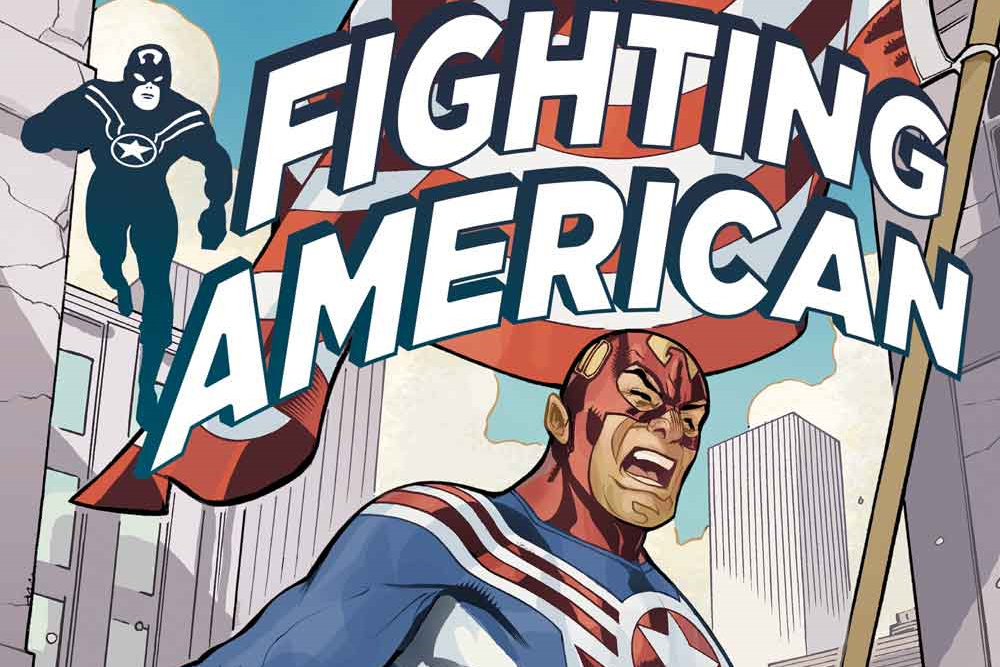
Everybody these days knows Captain America. Even if you haven’t been a fan of the comics since the Star-Spangled Avenger’s first appearance way back in 1941, you’ll know him from his big screen outings in three of his own movies plus as the mainstay of the Avengers films that anchor the Marvel Cinematic Universe.
But there’s another super-patriot out there, created by the same team who dreamed up Captain America, and while Fighting American might not have the global reach of his more famous cousin, even among comics fans, his time might be about to come again.
Although Fighting American doesn’t occupy the same Marvel Universe as Captain America, the histories of the two superheroes are inextricably linked, through the creative team of Joe Simon and Jack Kirby.
And while Captain America might be the flag-bearer, in more ways than one, of the Marvel Universe, there are dark and devious doings afoot in his early history that rivals any scheming machinations of his arch-enemy the Red Skull, and led directly to the creation of Fighting American.
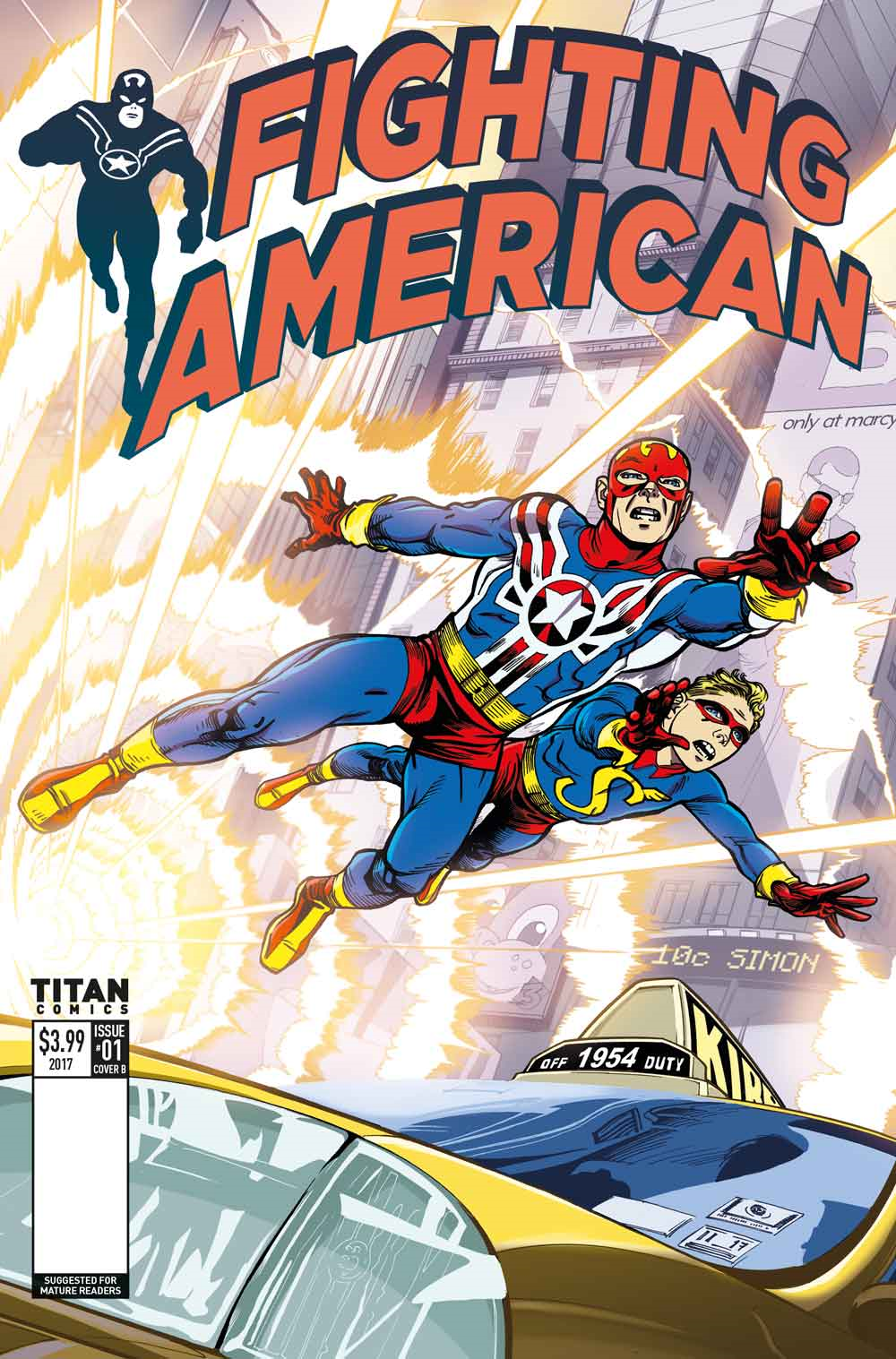
But first, who is Fighting American? Like the man under the Captain America mask is Steve Rogers, a puny guy given a shot at fighting the Nazis thanks to an experimental super-soldier serum, so Fighting American’s alter-ego is writer Nelson Flagg, forever in the shadow of his athletic, war hero brother Johnny. But when Johnny is killed by communist agents, Nelson makes a promise to track down his murderers. He, like Steve Rogers, takes part in an untested scientific process that sees his consciousness transferred to the corpse of his brother.
Adopting Johnny’s identity, Nelson Flagg becomes the costumed super-patriot Fighting American. This being 1953, he turns his attention on the Red Menace of communism, whereas Captain America had in the 1940s become famous for tackling Nazis and even memorably punching Hitler, something that has gained more traction as an internet meme in recent months, given the rise of the so-called alt-right in the United States.
Like Captain America had Bucky, Fighting American also had a teen sidekick called Speedboy, and together they took on a phalanx of communist-flavoured villains including the Russian dwarf Sawdoff, Rhode Island Red, and Super-Khakhalovitch.
But after having a massive hit on their hands like Captain America, why did Joe Simon and Jack Kirby bother with a new character who was similar to but not quite like their more famous creation? The answer is because they had to.
Simon, born in 1913 and Kirby – who celebrates the centenary of his birth at the end of this month – were young New Yorkers (Kirby, who went on to co-create such lasting comic legends as the Fantastic Four and Thor, from the city and Simon from Rochester, in New York state) when they came up with the concept of what was first called “Super-American”. Simon created the concept of what they would later re-christen Captain America, and he supervised artist Kirby on putting together the illustrations. The character was published by Timely Comics, the forerunner of what is now the massive Marvel empire.
They were young, and perhaps a little naive in business terms, and gave up the rights to their character for a relative pittance. After the first blush of superhero mania in the war years the genre lost its popularity somewhat until the mid-1950s, when Timely, now called Atlas, decided to try again and gave Captain America a new lease of life… but without his creators Simon and Kirby.
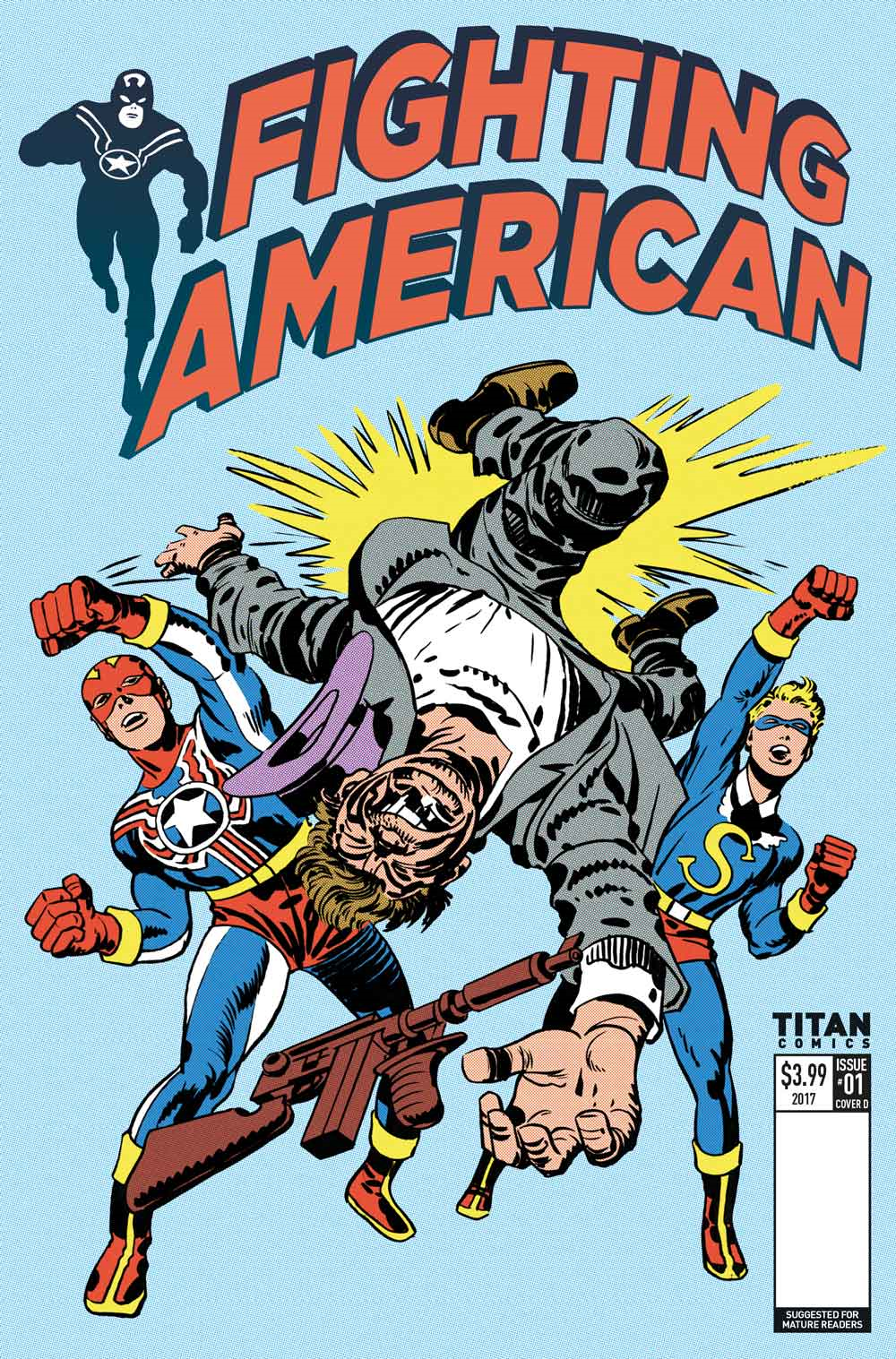
Joe Simon’s son Jim, an artist and writer based in New York, says, “Publishers in the United States were trying out superhero comics again in the 1950s. It was the Cold War period. Simon and Kirby had their own publishing company by now, Mainline Publications. Captain America was brought out of the mothballs by its publisher in 1953. Simon and Kirby had their cold war patriotic superhero ready to go also in 1953 when the first issue hit the news-stands. Cheated out of their original Captain America creation, the two would show Marvel how to make a better patriotic superhero, and what might have been for Marvel became the Fighting American for Mainline. While the superhero market was weak, Simon and Kirby’s Fighting American lasted a few issues longer than the relaunched Captain America.”
Simon and Kirby had left the nascent Marvel (though it wouldn’t be called that until the 1960s) because their dispute over the rights to Captain America, and according to Jim Simon, Fighting American was their answer to what they thought Captain America would have become in their hands had they continued to work on it.
The 1950s superhero revival didn’t last long, though, and it wasn’t until the 1960s when Stan Lee ushered in – along with artists like Jack Kirby and Steve Ditko, who history tells us had a lot more involvement in the creation of the stories than their credits as artists would suggest – the Marvel age of comics, which saw another new shot at fame for Captain America as part of the new title the Avengers… and set him and his Marvel Universe compatriots on the road to immortality.
Fighting American, though, was one of the many heroes relegated to the history books, which was a shame, says Jim Simon. “I absolutely enjoyed Fighting American as a kid,” he says. “I still enjoy reading the classic Fighting American reprints. It’s the ultimate patriotic superhero versus the wackiest, treacherous villains in comics, in my opinion.”
And you can’t keep a good ultimate patriotic superhero down. After decades of relative obscurity, the character is this autumn being relaunched with a brand new creative team – British, as it goes – telling bang-up-to-date adventures of Fighting American and Speedboy, published from October by the UK comics publisher Titan.
Edinburgh based writer Gordon Rennie and artist Duke Mighten are literally bringing the Fighting American into the present day… through time travel which sees Johnny Flagg and Speedboy deposited in 2017. “It’s literally a man-out-of-time story,” says Rennie. “They’ve dropped in from the 1950s and they have these 1950s attitudes… Fighting American is basically a classic Eisenhower Republican.
“They’re having to come to terms with a modern world where there’s not only technology they don’t understand, but social conventions have changed so much. What Fighting American might see as normal behaviour, even good manners, back in the 1950s is suddenly possibly sexist and chauvinistic.
“He’s desperate to get back home to the 1950s, but Speedboy is absolutely loving the 21st Century… he’s basically this 1950s teenager who’s suddenly bombarded by all these sexualised images in 2017 and he can’t get enough of it.”
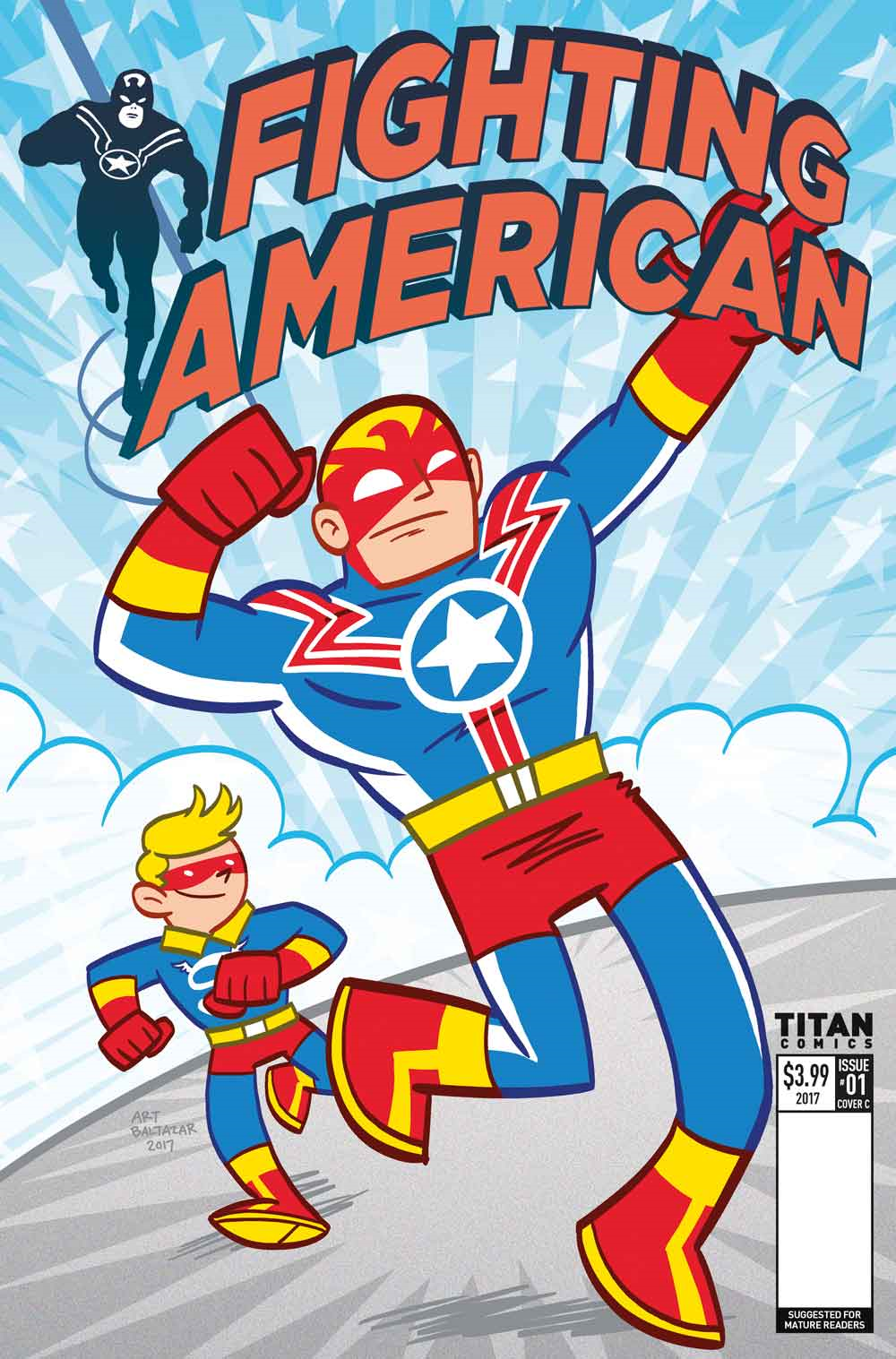
Titan comics has worked very closely with the estates of both Joe Simon and Jack Kirby to ensure that while the new run of Fighting American is relevant to modern audiences, it would still meet the approval of the original creators (Kirby died in 1994, Simon in 2011). David Leach, who is editing the book at Titan, says, “Titan had established a great relationship with both the Simon and Kirby estates when we were reprinting the Simon and Kirby archive and when we discussed our idea of bringing back Fighting American they were very enthusiastic and encouraging.
“They are fantastic to work with. They are very supportive of the project and passionate about ensuring the legacy of their fathers is honoured and continued.”
Jim Simon is certainly a big fan of the new direction and has had hands-on involvement with approving the forthcoming comic. He says, “The estates get to see all the scripts, as well as the art, the promotions, I guess just about everything. And we get to put in our comments. I think Gordon is doing some terrific writing with Fighting American, and wait until you see how dynamic Duke Mighten’s art is. Gordon has managed to transition the character into today’s world. Fighting American is learning about these times, and the reader will be amazed how these times are in some ways more and more similar to the 1950s. It’s back to the future!”
At a time when Captain America is embroiled in controversy among comics fans because Marvel have recently “outed” him as a long-time member of the universe’s fictional far-right terrorist group Hydra, which has disconcerted many readers, the focus on Fighting American is more fun.
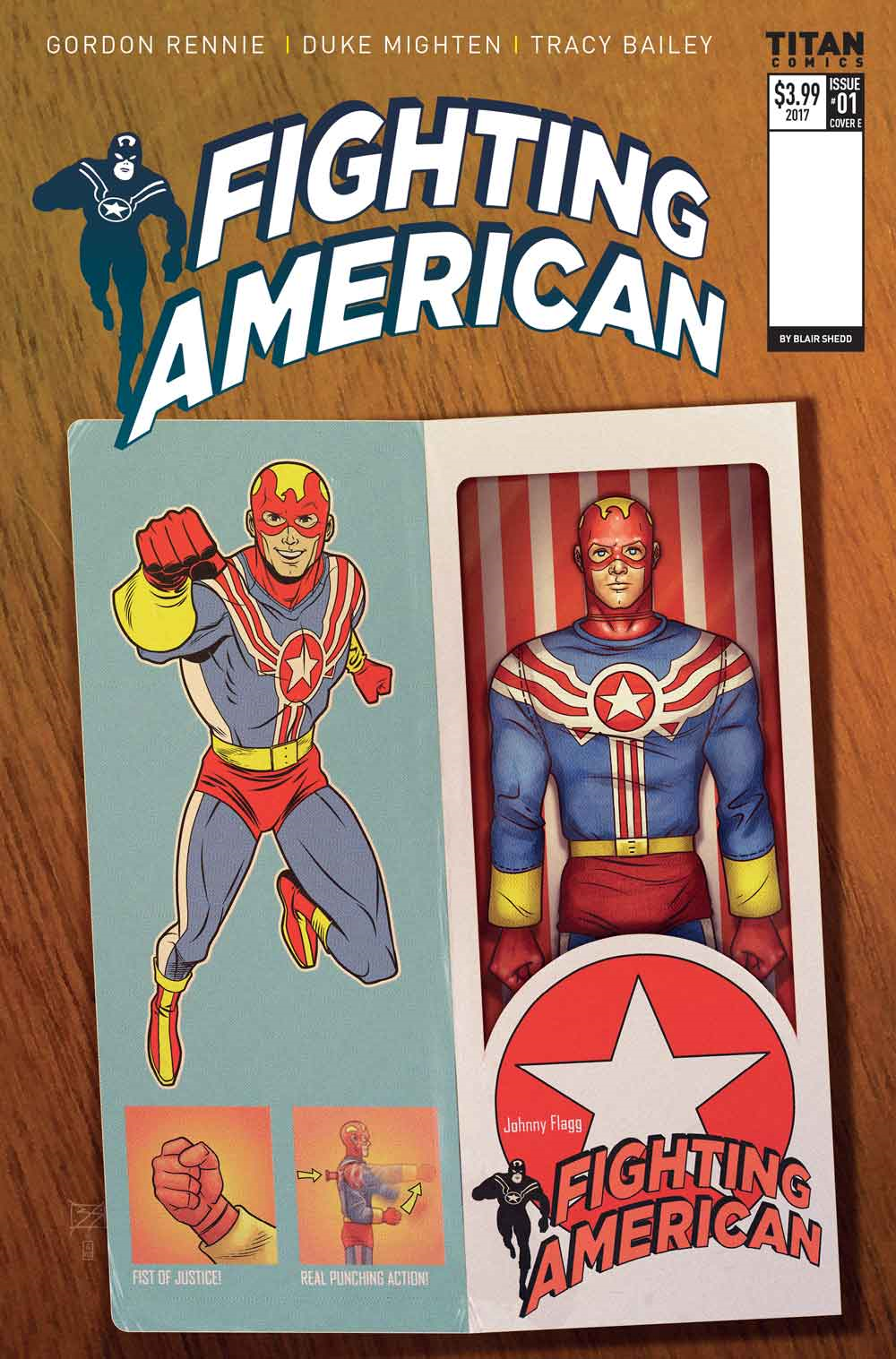
“Fighting American was an extraordinary character, big, bold, brash, dynamic,” says Leach. “And the same was true of the villains he fought. In a time when most superheroes these days are brooding, dark or crippled with continuity, we wanted to do one that celebrated the joie de vivre of the genre and how better than by reviving a character created by two of the greatest comic book creators of all times.”
There was a happier post-script to the Captain America story than Simon and Kirby experienced back in the 1940s and 1950s. Marvel settled out of court in 2003 for an undisclosed sum over the copyright row. It was too late for Jack Kirby, and Joe Simon was in his 90s.
Joe’s son Jim – who is carrying on the family tradition with his own graphic novel featuring a patriotic superhero, ShieldMaster – adds, “Fighting American’s time has come again. You can’t keep a good character down.”
Fighting American by Gordon Rennie and Duke Mighten is published monthly from October by Titan Comics, who also publish several volumes in the Simon and Kirby library featuring comics crossing genres such as superhero, crime and science fiction.
Join our commenting forum
Join thought-provoking conversations, follow other Independent readers and see their replies
Comments